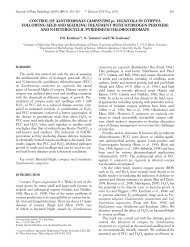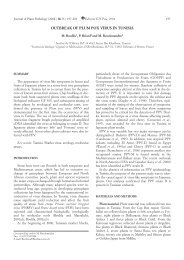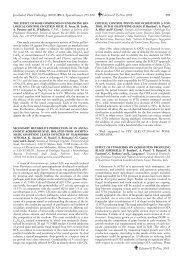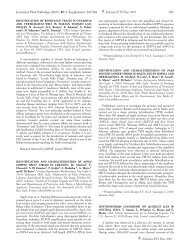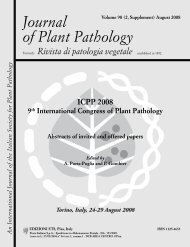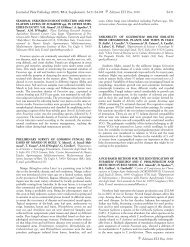Journal of Plant Pathology - Sipav.org
Journal of Plant Pathology - Sipav.org
Journal of Plant Pathology - Sipav.org
Create successful ePaper yourself
Turn your PDF publications into a flip-book with our unique Google optimized e-Paper software.
S1.34 Effects <strong>of</strong> prohexadione-calcium on grape cluster structure <strong>Journal</strong> <strong>of</strong> <strong>Plant</strong> <strong>Pathology</strong> (2011), 93 (1, Supplement), S1.33-S1.37<br />
in the biosynthesis <strong>of</strong> anthocyanidins and other<br />
flavonoids (Rademacher et al., 1992). Prohexadione is<br />
structurally similar to 2-oxoglutaric acid, enabling the<br />
compound to inhibit 2-oxoglutarate-dependent dioxygenases,<br />
which are involved in the formation <strong>of</strong> growth<br />
active gibberellins and in flavonoid metabolism<br />
(Rademacher, 2000). Our objectives were to quantify<br />
the response <strong>of</strong> grapes to prohexadione-calcium and to<br />
determine whether reductions in berry size or crop yield<br />
could be related to increased fruit and wine quality.<br />
MATERIALS AND METHODS<br />
Experimental design. The experiments were conducted<br />
in the years 2009 and 2010 on field grown<br />
grapevines (Vitis vinifera cv. Grüner Veltliner on Kober<br />
5BB rootstock). The experimental vineyard was located<br />
at the Federal Research Station Agnesh<strong>of</strong>, Klosterneuburg,<br />
(Austria). The vineyard was planted with a<br />
vine-by-row spacing <strong>of</strong> 1.20 × 3 m in south orientation,<br />
with a permanent green ground cover. The vines were<br />
trained to espalier with two vertically positioned canes.<br />
Soil and canopy management and grape protection<br />
strategy for the year 2009 and 2010 [six applications <strong>of</strong>:<br />
sulphur 0.3%, sulphur 0.3% and dithianon 0.05%,<br />
azoxystrobin/folpet (combined product) 0.2%, proquinazid<br />
0.025% and cymoxanil/dithianon (combined<br />
product) 0.1%, metalaxyl-m/folpet (combined product)<br />
0.2% and metrafenone 0.02%, cymoxanil/dithianon<br />
(combined product) 0.1% and meptyldinocap 0.06%]<br />
were carried out as in commercial vineyard. In the<br />
evenings <strong>of</strong> the 9 June 2009 and 22 June 2010, respectively,<br />
when sixty percent <strong>of</strong> the flowerhoods were fallen<br />
(BBCH 66) (Lancashire et al., 1991), prohexadione-calcium<br />
(1,8 kg/ha; 400 l water) with citric acid (0,1%) was<br />
applied with a motorized backpack sprayer (STIHL SR<br />
420). Two applications <strong>of</strong> botryticides (mepanipyrim<br />
0.12%) were done at BBCH 73 – BBCH 75 (Table 1).<br />
All experimental treatments were replicated in four randomized<br />
plots consisting <strong>of</strong> 10 vines.<br />
Weather data. Data were recorded on an ADCON<br />
Weather Station located on the trial site.<br />
Grape bunch length. Length was measured <strong>of</strong> two<br />
bunches <strong>of</strong> the third shoot, counted from the basis <strong>of</strong><br />
Table 1. Nature <strong>of</strong> treatments and dates <strong>of</strong> application.<br />
Number Treatment Application date<br />
1 Control<br />
2 Prohexadione-calcium 9 and 22 June 2010<br />
3 Prohexadione-calcium<br />
and Mepanipyrim<br />
9 and 22 June 2010<br />
14 and 19 July 2010<br />
4 Mepanipyrim 14 and 19 July 2010<br />
the cordon. If the third shoot was weak, then bunches<br />
<strong>of</strong> the next shoot were considered.<br />
Bending index. The bending index was developed to<br />
assess the compactness <strong>of</strong> grape clusters. The index was<br />
determined using the following scale: 1= firm, 2= flexible,<br />
3= bending up to a maximum <strong>of</strong> 45°, 4= bending<br />
up to a maximum <strong>of</strong> 90°, 5= bending above 90°. One<br />
hundred grapes clusters were analyzed in each treatment<br />
for grape bunch length and bending index.<br />
Weight parameter. In 2009 and 2010 the weight <strong>of</strong><br />
the crop was measured with a laboratory scale on twelve<br />
vines per treatment and replicates.<br />
Berry diameter. The diameter <strong>of</strong> all berries from<br />
three clusters per treatment was recorded. To this aim,<br />
berries were cut with a scalpel through the middle and<br />
measured with a ruler.<br />
B. cinerea disease serverity. The severity <strong>of</strong> B. cinerea<br />
attacks was assessed according to the EPPO Standards<br />
[PP 1/17 (2)] on 100 bunches on 15 September 2009<br />
and 13 September 2010.<br />
Fourier transform infrared spectroscopy. Bunch<br />
ripeness was determined on 100 berries per treatment<br />
with Fourier transform infrared spectroscopy (FTIR),<br />
which is used for routine quantification <strong>of</strong> wine and<br />
grape parameters (for example sugar concentration). A<br />
Foss instrument (WineScan FT 120, Type 77110 with<br />
sampling 5027) was used to analyse the must samples<br />
(Griffiths and de Hasseth, 2007).<br />
Data analysis. SPSS Statistics 17.0 was used for data<br />
analysis. Significance <strong>of</strong> main effects was determined by<br />
analysis <strong>of</strong> variance (ANOVA) and Tukey.<br />
RESULTS<br />
There was no significant difference between the<br />
treatments on cluster length (Fig. 1). Likewise, cluster<br />
weight did not differ significantly in the variants (ANO-<br />
VA, significance = 0.350) (Fig. 2).<br />
When looking at the frequency with which a certain<br />
berry diameter was observed, a significantly higher number<br />
<strong>of</strong> berries with a diameter <strong>of</strong> 3 mm was found in the<br />
variant prohexadione-calcium. Similarly, a higher number<br />
<strong>of</strong> berries with a diameter <strong>of</strong> 8-10 mm was found in this<br />
treatment as compared with the control (Fig. 3).<br />
As for the density index, in the year 2009, the treatment<br />
with prohexadione-calcium + botryticide differed<br />
significantly α=0,000 (α>0.05) from the control and the<br />
variant prohexadione-calcium and botryticide, which<br />
was the treatment with the loosest grapes. In 2010,



